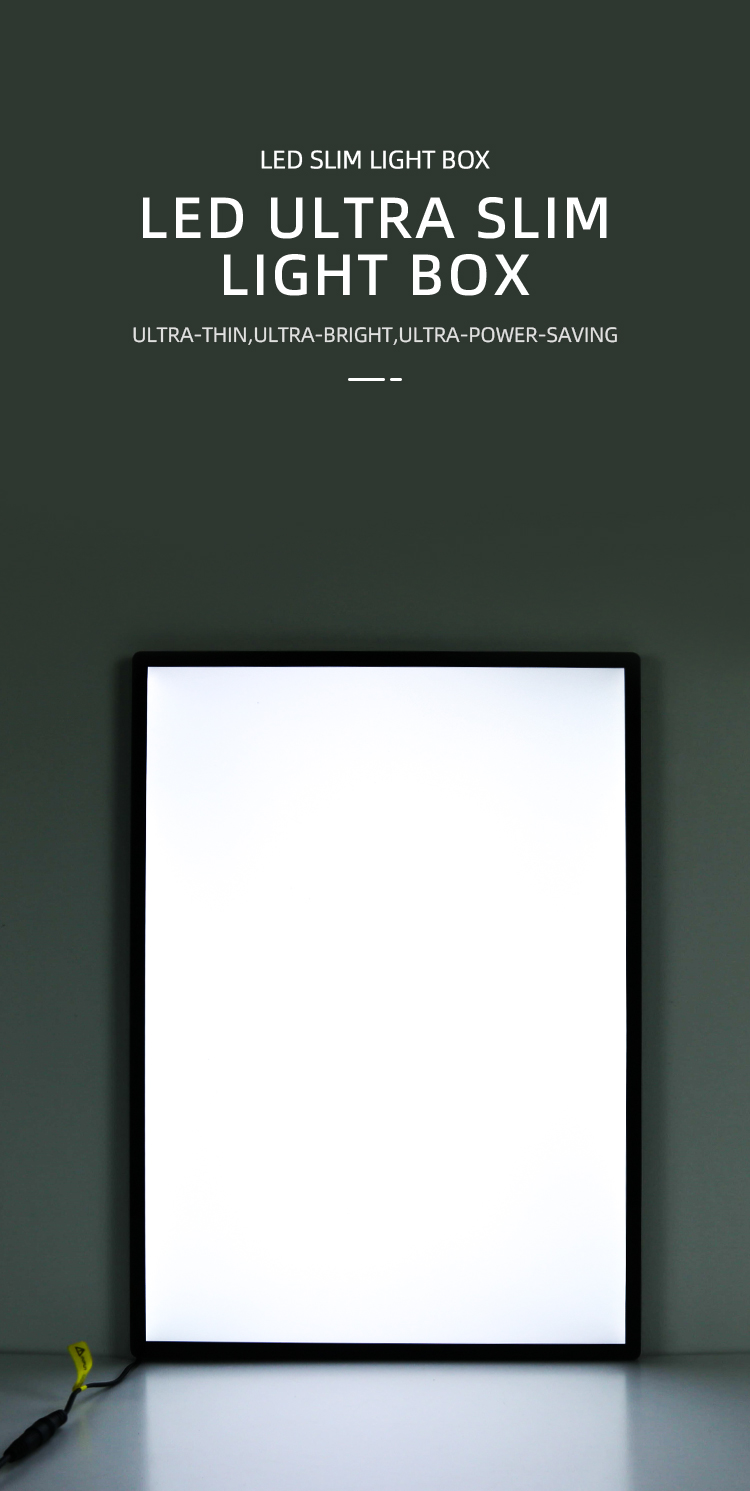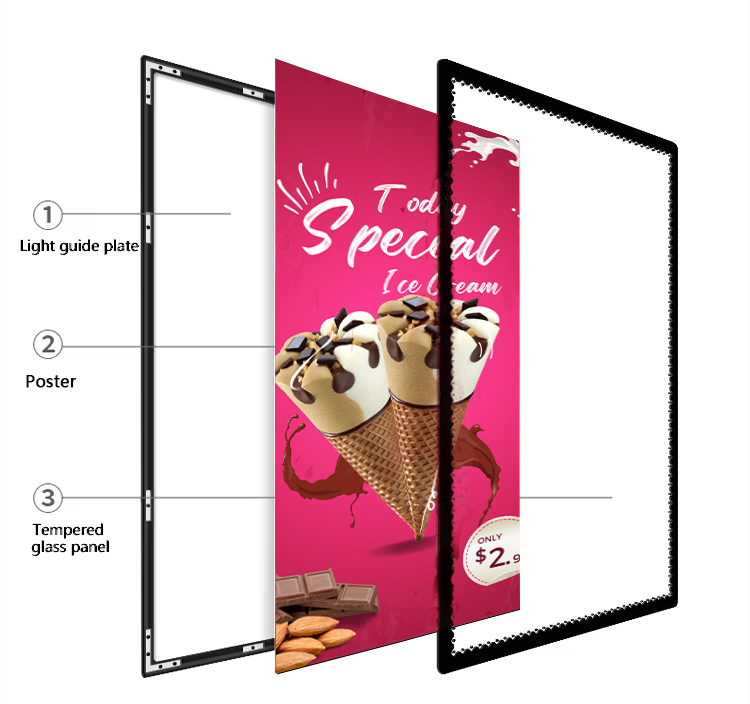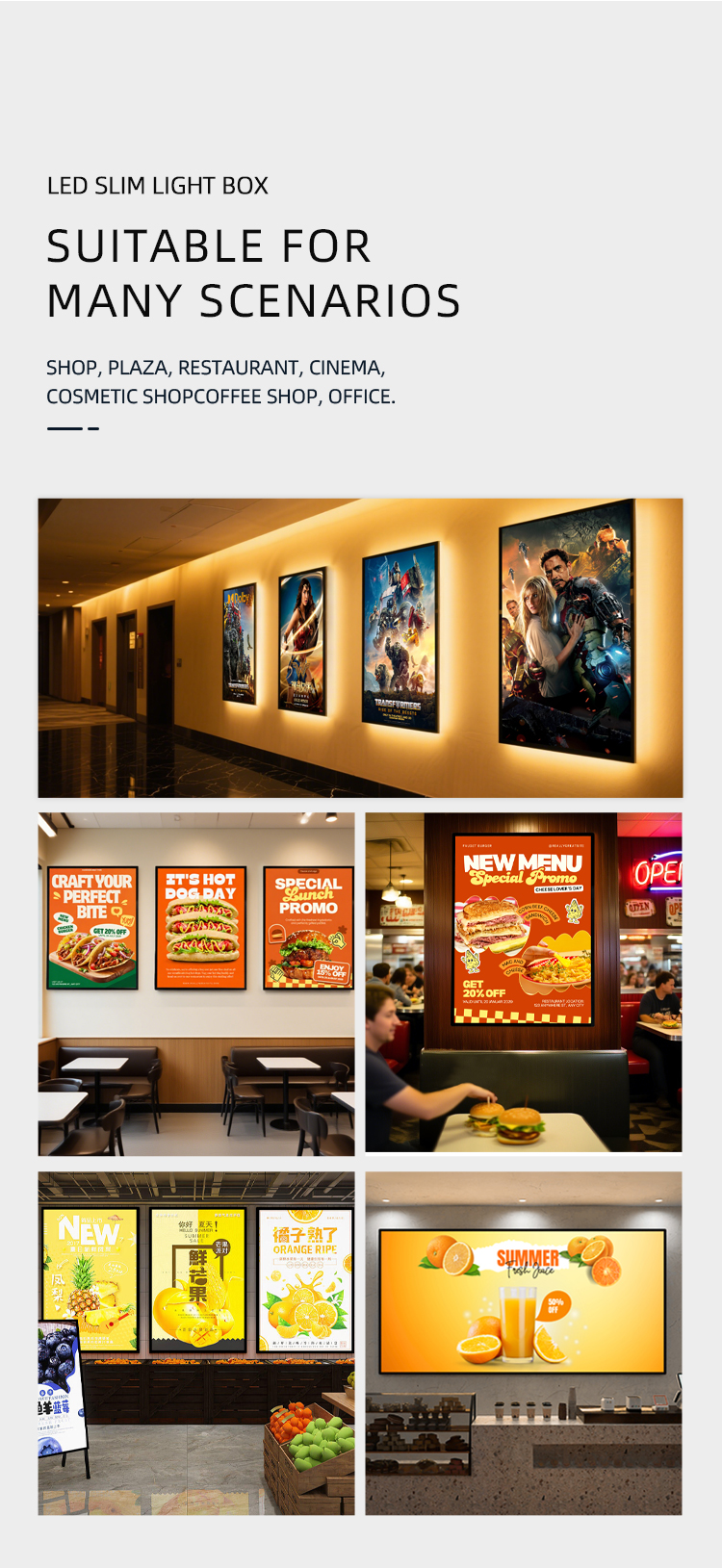 +86 0(20) 8488 0520
+86 0(20) 8488 0520
 +86 0(20) 8488 0520
+86 0(20) 8488 0520
An ultra slim light box is a modern illuminated display frame designed to showcase graphics, posters, menus, or advertisements in a sleek, minimal profile. Instead of bulky fluorescent tubes used in traditional light boxes, these use LED technology for a thinner, brighter, and more energy-efficient display.

Ultra slim light boxes are typically built with:

| Feature | Ultra Slim Light Box | Traditional Light Box |
|---|---|---|
| Thickness | 0.4inch (10mm) | 3–5 inches (75–125 mm) |
| Weight | 2–10 lbs (depending size) | 8–20 lbs |
| Light Source | LED SMD4014 | Fluorescent tubes |
| Power Efficiency | High | Moderate |
Because of their sleek profile, ultra slim LED light boxes work well in tight spaces while still delivering bright, eye-catching illuminated signage. They have become a go-to choice for retail displays, menu boards, and advertising signage where space and style matter.
Ultra slim light boxes aren’t just about good looks—they’re built to work hard for your brand. Here’s what makes them a smart pick for businesses in the U.S.
| Feature | Why It Matters | Typical Benefit in U.S. Market |
|---|---|---|
| Slim aluminum frame | Lightweight and durable | Easier shipping and installation |
| LED lighting | Low energy use, long life | Lower utility and maintenance costs |
| Graphic change system | Magnetic or snap frame | Quicker ad updates for seasonal campaigns |
| Indoor | Suitable for restaurants, etc | Same brand look across locations |
Ultra slim light boxes are used almost everywhere because of their clean look, bright LED lighting, and easy setup. Here’s where you’ll see them the most:
Stores use LED ultra slim light box displays to showcase promotions, product launches, and seasonal campaigns. The slim frame blends with modern store designs and helps grab attention without taking up space.
In restaurants and coffee shops, LED menu boards in ultra slim frames make menus easy to read, even in dim lighting. Swapping out graphics is quick, which is perfect for businesses that change menus often.
Trade shows and events use custom ultra slim light boxes to make booths stand out. Their bright illumination highlights graphics and products, helping attract more foot traffic.
Businesses often use thin LED light box frames in lobbies or meeting areas to display branding, company values, or event announcements in a modern, professional way.
In busy public areas, ultra thin illuminated signage delivers vibrant, high-contrast ads that people notice even from a distance. They work well for both permanent and seasonal campaigns.

When you’re looking at an ultra slim light box, certain specs make the most difference in how it performs and how easy it is to use for your business. Here’s what to focus on:
A good LED ultra slim light box display should spread light evenly with no dark spots or bright glare. Uniform brightness keeps your message or image looking sharp from every angle. For indoor spaces, 2000–3500 lux is common.
Choose a thin LED light box frame that fits your style and space.
If you need to swap ads or menus regularly, magnetic ultra slim light boxes and snap frame designs save time. No tools are required—you just open the frame or lift the magnetic cover, slide in the new print, and you’re done.
LED technology keeps these light boxes energy-efficient. Most models run at low voltage (12V/24V) and consume much less power compared to older fluorescent styles. Look for Energy Star-certified units if possible.
These come in many dimensions—small LED photo frames to large advertising light boxes. Mounting styles include:
| Feature | What to Look For |
|---|---|
| Brightness | Even light spread, 2000–4000 lux depending on use |
| Frame Design | Thin aluminum alloy, custom sizes, color options |
| Graphic Change Method | Magnetic front or snap frame for tool-free swaps |
| Power Use | 12V/24Vvoltage, Energy Star options |
| Sizes and Mounting | Wall, hanging, desktop, freestanding, indoor |
Ultra slim light boxes are typically under 1 inch thick, while traditional light boxes can be 2–5 inches deep or more. The slim profile gives them a cleaner, more modern look that works well in retail, hospitality, and corporate spaces. They fit flush against walls, making them ideal where space is tight. Traditional versions, although functional, can look bulkier and dated.
Upfront, an ultra slim light box may cost slightly more due to the LED light guide panels and precision frame design. But the energy savings from LED technology, plus the lower maintenance needs, usually result in a better return on investment over time. Traditional light boxes with fluorescent tubes can use more power and require more frequent bulb replacements, which adds to maintenance costs.
Ultra slim LED light boxes provide even, bright illumination with no dark spots, which makes graphics pop and captures attention quickly. This is especially important for retail signage, menu boards, and advertising displays where first impressions count. Traditional boxes can still be effective, but they may not match the sharp, vivid look of an LED ultra thin illuminated signage setup.
LED-based ultra slim light boxes often last 50,000 hours or more, meaning years of consistent use with minimal upkeep. The aluminum frame and acrylic panel construction hold up well in high-traffic areas. Traditional light boxes tend to wear faster due to older lighting tech and bulkier frames, making replacements or refurbishing more frequent.
When you’re investing in an ultra slim light box, the supplier or manufacturer you choose makes a huge difference in product quality and long-term value. Here’s what I always look for in the U.S. market:
Go with companies that have years of hands-on experience making LED ultra slim light box displays. The more projects they’ve completed, the more likely they can produce consistent, high-quality results. Experienced manufacturers also tend to stay up to date with the latest energy-efficient light box technology.
Check if they follow UL, CE, or ISO certifications. These ensure the slim LED light box meets electrical safety standards, durability requirements, and environmental guidelines—important for commercial setups in malls, airports, or retail spaces.
A reliable LED light box manufacturer should offer custom sizes, frame colors, brightness levels, and mounting options. If you’re in retail or hospitality, they should help design a custom ultra slim light box that matches your branding and space layout.
Look for warranty coverage on both the frame and LEDs. A good supplier will also have responsive customer service for repairs, replacements, or installation help.
Ask for past project examples—especially from U.S.-based clients. Real-world photos of ultra thin illuminated signage or magnetic ultra slim light boxes they’ve done will tell you more than any brochure. Reading reviews will show you how they handle deadlines, installation, and long-term product performance.
When setting up an ultra slim light box, the right placement makes all the difference.

Most ultra slim light boxes or snap frame light boxes are made for quick graphic changes.

A little routine care can keep your LED ultra slim light box display looking new for years.
When budgeting for an ultra slim light box, a few main factors will impact the price:
Paying a bit more for trusted LED light box manufacturers often means fewer replacements, better warranties, and a cleaner, consistent display for your signage or advertising needs.
 online service
online service +86 0(20) 8488 0520
+86 0(20) 8488 0520 sales@cityluxled.com
sales@cityluxled.com +8613640601669
+8613640601669